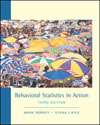Mark W. Vernoy,
Palomar College
Diana J. Kyle,
Fullerton College
| Axes | are the horizontal and vertical lines of a graph.
|
 |
 |
 |
| Cumulative frequency polygon | is plotted using the upper real limit of the class interval as the most representative single point. The cumulative frequency is represented along the ordinate. Since cumulative frequency is the total number of scores that fall below the upper real limit of the class interval, the last point plotted at the highest class interval is equal to n. The cumulative frequency line is not brought down to the abscissa after the last point but is allowed to hang in the air.
|
 |
 |
 |
| Cumulative percent polygon | also called percentile, is plotted the same as the cumulative frequency polygon, except cumulative percent is represented along the ordinate. Because the cumulative percent polygon's percentage of scores is below the upper real limit, it is easier to interpret.
|
 |
 |
 |
| Cumulative relative frequency polygon | is plotted at the upper real limit of the class interval. The cumulative relative frequency is the proportion of scores that fall below the upper real limit of the class interval and the line connecting to the point plotted at the highest class interval is left hanging.
|
 |
 |
 |
| Frequency histogram | is a type of bar graph where the width of each bar indicates the class interval size and the height of each bar indicates the frequency of the class interval. Histograms are used to illustrate the number of participants in each class interval. Each bar of the histogram extends from the lower to the upper real limits of the class interval.
|
 |
 |
 |
| Frequency polygon | is a type of line graph that portrays the same information found in a histogram except the midpoint of the class interval is the single point plotted to represent the entire class interval. Lines connect the points on the graph and connect to the abscissa on both the extreme right and left ends of the graph. Like the histogram, the frequency polygon is also used to illustrate the number of participants in each class interval.
|
 |
 |
 |
| Relative frequency polygon | is plotted the same as a frequency polygon, except the relative frequencies are represented along the ordinate. Because relative frequencies are the proportion of scores that fall within the class interval, similar sets of information that have different numbers of participants can be compared graphically using the relative frequency polygon.
|
 |
 |
 |
| Stem-and-leaf diagram | is a technique that displays data visually by dividing the raw score into two parts, a stem and a leaf. The leaf is normally the last digit of the score and the stem is the remaining digit(s) of the score.
|
 |
 |
 |
| X-axis | also known as the abscissa, is the horizontal line of a graph. In a graph of a frequency distribution, it is customary to represent the dependent variable along the abscissa. However, the independent variable is represented along the abscissa in a graph depicting the results of an experiment.
|
 |
 |
 |
| Y-axis | also known as the ordinate, is the vertical line of a graph. In a graph of a frequency distribution, it is customary to represent the frequency along the ordinate. When the graph depicts the results of an experiment, the dependent variable is represented along this axis.
|



 2002 McGraw-Hill Higher Education
2002 McGraw-Hill Higher Education

 2002 McGraw-Hill Higher Education
2002 McGraw-Hill Higher Education